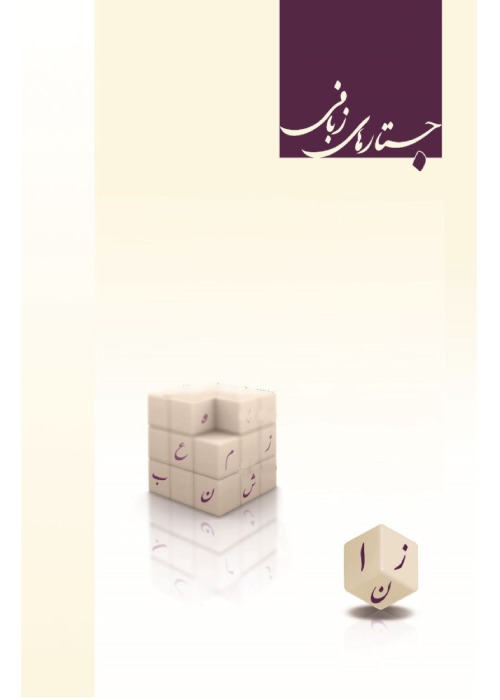An Investigation of Persian Binomials based on Constraints Model
In every language, there are some constructions where two constituents are put together to form a lexical item. These constructions are called binomials. In this term, “ nomi” ( which means “name”) can refer to names, adjectives, verbs, adverbs and conjunctions. These constructions can be just the repetition of the same word, like “davan davan”, or can be reduplication, like “ketab metab” which has a phonological motivation. They can be onomatopoeia, like “tick-tack” or can be of a kind where there is a just a semantic motivation, like “jang and solh”. But terminologically, binomials refer to the sequence of two words pertaining to the same form-class, and ordinarily connected by some kind of lexical link. One point in binomials relates to the order of constituents and which factors or constraints determine their order. In this regard, there is a model called Constraints’ Model (2014). The model has some constraints which determines the order of constituents in binomials.
The paper aims to investigate Persian binomials based on Constraints’ Model. Study questions: In this regard, the study questions are:1-To how extent the order of constituents in Persian binomials can be determined based on semantic-pragmatic constraints, non-metrical-phonological constraints, metrical-phonological constraints, and frequency and alphabetic order constraints which are mentioned in Constraints’ Model? 2- To how extent Constraints’ Model can be a criterion to determine the order of constituents in Persian binomials? 3-For those Persian binomials whose orders can’t be determined using Constraints’ Model, what constraints can be defined?
The research is done using Constraints’ Model. The data were extracted from twenty Persian novel, the newspapers “Hamshahri” and “Iran” in a one year period, Persian dictionary and web. From the corpus, 1957 binomials were extracted, many of which were ignored because they were in the groups “repetition” and “reduplication”. Finally there were 593 reversible and irreversible binomials. To do the research, all these 593 binomials were divided into two groups “reversible” and “irreversible”. To determine the (ir) -reversibility of Persian binomials, Persian Language Data Base (Bijankhan Corpus) was used, so following Mollin’s method (2013), the binomials appearing just in one order were considered irreversible and the ones appearing in both orders were considered reversible. For reversible binomials, it was attempted to find their preferred order. To find the preferred order of reversible binomials, the researcher referred to the frequency in Persian Language Data Base and web and the frequency number of both order were found. If the frequency occurrence of one order was significantly higher than the other order, that order was considered as the preferred order, but if the frequency occurrence of two different orders in one binomial wasn’t different significantly, that binomial was removed from research, because there wasn’t any preferred order which can be determined by Constraints’ Model. Then the irreversible binomials and reversible binomials with a preferred order were analyzed using Constraints’ Model. Analysis: Analysis of research data, considering the occurrence order of binomials in Persian Language Data Base (Bijankhan Corpus) and web showed that among 593 binomials, 534 ones were irreversible and 59 ones were reversible. The 534 irreversible binomials were analyzed using Constraints’ Model.
Data analysis showed that among 534 irreversible binomials, Constraints’ Model can determine the order of 520 binomials (97/3), but in research corpus, there were 11 binomials (2/7) whose order can’t be determined using Constraints’ Model. The analysis results for reversible binomials showed that among 45 reversible binomials (with a preferred order), Constraints’ Model can determine the order of 44 binomials (97/7), but there were one reversible binomial (2/3) which couldn’t be explained Constraints’ Model. To answer the first question of the research, we can say that Constraints’ Model has determined the order of 97/4 of binomials (both irreversible binomials and reversible binomials with a preferred order) in Persian. So it is concluded that Constraints’ Model is suitable to determine the order of constituents in Persian binomials. But for those Persian binomials whose order can’t be determined using Constraints’ Model, some constraints were proposed which are: dominance principle, initial sonority of second syllable principle, unstressed vowel length principle, analogy principle, importance principle, coda’s initial sonority principle,
- حق عضویت دریافتی صرف حمایت از نشریات عضو و نگهداری، تکمیل و توسعه مگیران میشود.
- پرداخت حق اشتراک و دانلود مقالات اجازه بازنشر آن در سایر رسانههای چاپی و دیجیتال را به کاربر نمیدهد.


